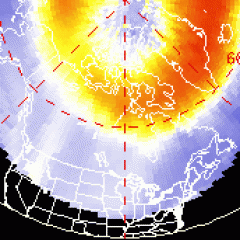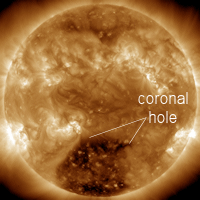~SPACE WEATHER UPDATE~ CHANCE OF MAGNETIC STORMS~CME TO ARRIVE DECEMBER 29-30TH [1]
~SPACE WEATHER UPDATE~ CHANCE OF MAGNETIC STORMS~CME TO ARRIVE DECEMBER 29-30TH

CHANCE OF MAGNETIC STORMS: NOAA forecasters estimate a 20% to 40% chance of polar geomagnetic storms on Dec. 28-29 in response to the arrival of one or more CMEs. High-latitude sky watchers should be alert for auroras. Aurora alerts: text [2], voice [3].
ON MARS, TOO: Sunspot 1387 erupted on Christmas day, hurling a coronal mass ejection (CME) directly toward Mars. According to analysts at the Goddard Space Weather Lab, impact will occur on Dec. 30th at 1800 UT (+/- 7 hr). Click to view an animated forecast track:
Unlike Earth, Mars does not have a global magnetic field. Instead, the Red Planet has "magnetic umbrellas." These are fossil remnants of an ancient global magnetic field that decayed billions of years ago. When a CME hits Mars, the action happens in the umbrellas' canopies. Because the umbrellas are scattered around Mars [5], martian auroras can theoretically occur even near the equator.
Different world, different space weather [6].

![]()
Solar wind
speed: 282.7 km/sec
density: 4.3 protons/cm3
explanation [7] | more data [8]
Updated: Today at 1726 UT
![]()
X-ray Solar Flares
6-hr max: C7 1425 UT Dec28
24-hr: C7 1425 UT Dec28
explanation [9] | more data [10]
Updated: Today at: 1700 UT
![]()
![]()
![]()
Daily Sun: 28 Dec 11
![]()
![]()
Sunspots 1386 and 1387 have "beta-gamma" magnetic fields that harbor energy for M-class [9] solar flares. Credit: SDO/HMI
![]()
![]()
![]()
Sunspot number: 126
What is the sunspot number? [12]
Updated 27 Dec 2011
Spotless Days
Current Stretch: 0 days
2011 total: 2 days (<1%)
2010 total: 51 days (14%)
2009 total: 260 days (71%)
Since 2004: 821 days
Typical Solar Min: 486 days
Updated 27 Dec 2011
The Radio Sun
10.7 cm flux: 140 sfu
explanation [13] | more data [14]
Updated 27 Dec 2011
![]()
![]()
![]()
Current Auroral Oval:
![]()
Switch to: Europe, USA, New Zealand, Antarctica
Credit: NOAA/POES
![]()
![]()
![]()
Planetary K-index
Now: Kp= 1 quiet
24-hr max: Kp= 1 quiet
explanation [16] | more data [17]
![]()
Interplanetary Mag. Field
Btotal: 11.5 nT
Bz: 0.3 nT north
explanation [18] | more data [19]
Updated: Today at 1727 UT
![]()
![]()
![]()
Coronal Holes: 28 Dec 11
![]()
![]()
A solar wind stream flowing from this coronal hole could reach Earth between Dec. 29th and 30th. Credit: SDO/AIA.
Category:
- Ground Crew Updates [21]



